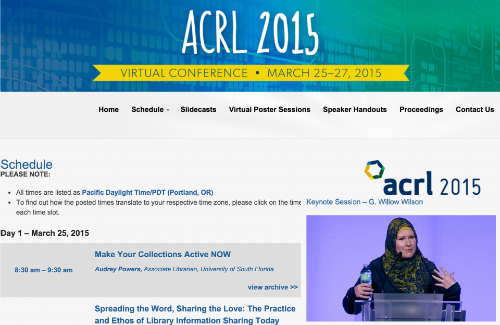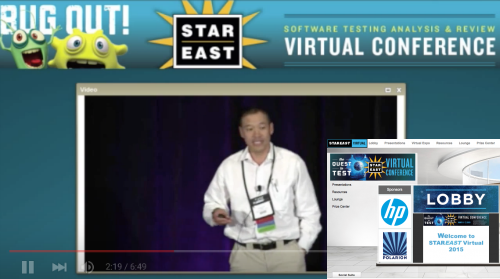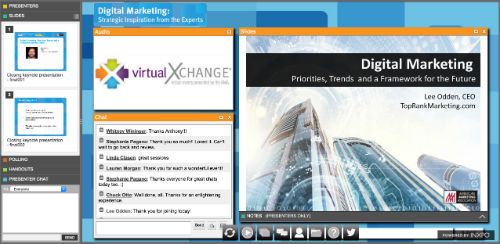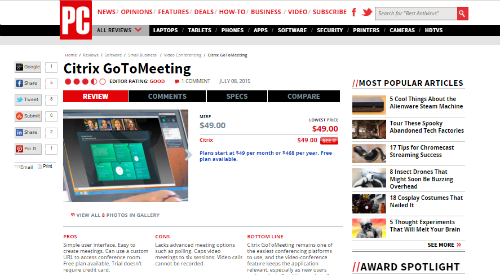
The Internet has created a space where meaningful conversations, connections and content creation can happen anywhere in the world. As a result, content marketing tactics have evolved to leverage all the Internet has to offer–and one of those tactics is virtual conferences.
For decades, real-world conferences have been an effective way for businesses of all kinds to attract and engage prospective customers. When done right, real-world events allow businesses to shape and spread their message through content to a captive audience, all while networking, establishing brand credibility, and moving people through the sales process.
Virtual conferences aim to do all of the same things as a real-world event, while also being more convenient, affordable and inclusive.
Since coming on the scene in 2007 -2008, virtual conferencing technology has greatly improved and a growing audience is welcoming virtual event opportunities. In fact, recent research by Content Marketing Institute shows that 25 percent of B2B marketers named virtual conferences as a top content marketing tactic for 2016.
Definition: Virtual Conference
A virtual conference is a web-based event that brings many of the content marketing elements of a real-world event to life online. From breakout sessions and networking to keynote speakers and Q and A, virtual conferences can be an easy and accessible alternative to live events.
Virtual conferences can range from simple to the extravagant, with platform providers offering a range of options to customize the look and feel of the conference space. In addition, there are often hybrid events, which combine both online-only and live conference elements.
Pros
As technology continues to evolve, it will become more and more important for businesses and organizations to connect with their audiences online. Virtual conferences uniquely combine a variety of marketing tactics such as social media promotion, video and live blogging. Here are some of the top benefits of virtual conferences as a content marketing tactic:
- They allow companies with smaller marketing budgets to put on quality, engaging events where a mix of brand and 3rd party content can be delivered to prospective customers.
- Virtual events can result in better leads because participant information is easily captured during the event and brands can engage attendees in real-time.
- Many virtual events offer presentation playback at the convenience of the attendee, making it easier to consume more of the content being presented.
- Attendees can save time and money by eliminating travel which may attract a larger audience.
- Messaging systems within Virtual Conference platforms enable speakers or the moderators to easily push additional content out during or after the presentation such as handouts, case studies or worksheets.
- The attendee comments within Virtual Conference platforms can be curated and published as a stand alone blog post or as part of a wrap-up post.
Cons
While virtual conferences offer a number of exceptional benefits, they’re not a one-size-fits-all marketing solution. Disadvantages of virtual conferences include:
- Managing an online event is similar to an offline event, but online events may require investments in new technologies.
- Online platforms can take some getting used to and may alienate part of the audience.
- A low cost of entry and the virtual nature of the event can make it easy for attendees to leave early or not show up at all.
What the Marketing Industry Saying About Virtual Conferences
“Twice a year, I host a ginormous virtual event for my brand, GroupHigh. This online conference has generated and converted more leads than any other tactic I’ve implemented. I think these online conferences have been so successful because I spend a ton of time vetting my speakers and the topics they present on. Forward thinking, new information where marketers feel like they will be left out of the loop if they miss the event is so important to me!”
Kristen Matthews, Marketing Director at GroupHigh.
“Virtual events also allow a potentially greater breadth of customization options. The only limitation to virtual events is your own imagination. The space can be big or small; simple or elaborate. Providers have created past virtual events that look like convention centers, malls, actual physical landmarks, and locations like London or New York.”
Dave Smith, senior technology editor at Tech Insider (Source: Inc.)
Brand Examples of Virtual Conferences
From big-wig companies like Apple to smaller professional industry associations such as the Idaho Science Teachers Association, organizations of all sizes are integrating virtual conferences into their marketing strategies.
Association of College & Research Libraries
The Association of College & Research Libraries (ACRL) is an higher education association for more than 11,000 librarians and other interested individuals. Earlier this year, it held its annual conference as a hybrid event.

For those who didn’t travel to the real-world event in Seattle, live webcasts featuring real-time interaction opportunities were offered, and the sessions were run on a real-time schedule just like the live event.
STAREAST by TechWell
STAREAST by Techwell is a software testing and review conference hosted in Orlando, FL. This hybrid event allows online participants to watch keynote speakers, technical presentations and live interviews throughout the five days of the event. Below is a little peek at what the conference space looks like.

American Marketing Association
Our very own Lee Odden recently participated in a virtual conference put on by the American Marketing Association (AMA). The event was solely held virtually, and the schedule was simple and straight-forward. Below is a look at the presentation dashboard where attendees could chat with each other, post questions to the speaker and download handouts provided.

Virtual Conference Best Practices
- Treat your virtual conference with similar content goals as a real-world event. While the venue is different, the mission of the conference itself is the same: to positively connect your audience with your brand through presentation content and encourage them to take some sort of action (e.g. sign up as a new member, ask for more information on your product, etc.)
- Planning makes perfect. Closely vet your speakers, whether internal or 3rd party, and the topics they’ll be speaking on. Communicate with them regularly leading up to the event and create a detailed event schedule so participants know what they’re getting.
- Market it hard. Marketing any event is crucial, but remember that people aren’t buying a plane ticket to attend a virtual event. Online events require far less commitment than real-world events, so keeping your event in front of people with marketing content is important. Use email, press releases, social media, blogging and any other relevant tactic.
- Make it easy for people to spread the word. Create shareable content such as pre-written tweets or boilerplate content for a blog post for before, during and after the event.
- Make it visual. Visual content captures and keeps audience attention. Period.
- Incorporate live elements. Allowing people the ability to view presentations and interact in real-time adds major value.
- Liveblog content. As with real-world events, presentations that occur virtually present a compelling opportunity for content creation by capturing tips, insights, quotes and statistics from the speakers for publishing on your blog. Encouraging attendees to do the same creates a multiplier effect for exposure of your conference.
Virtual Conference Software and Resources
There are a number of different virtual conferencing software platforms on the market. Many offer multiple tiers of functionality and pricing to customize the virtual event experience. Some of the most popular Virtual Conference platforms include:
- Cisco’s WebEx
- Adobe Connect
- Citrix GoToMeeting
- InterCall
- Communique
- INXPO

For more information on virtual conference platforms, PCMag.com and G2Crowd.com both offer useful reviews.
Virtual conferences will likely never replace traditional real-world events completely. After all, we’re still humans and face-to-face interaction is important. However, as technology continues to evolve and the need to create content-focused experiences for prospective buyers increases, marketing strategies need to consider solutions like virtual conferences.
Are virtual conferences going to be part of your content marketing evolution? Be sure to check out some of the resources included in this article and you may find out.
Have you experienced producing a virtual conference? How have you used virtual conferences for your content marketing?
If you liked this post, be sure to check out the content marketing tactics index page with links to over 25 posts similar to this one.
Top image: Shutterstock


